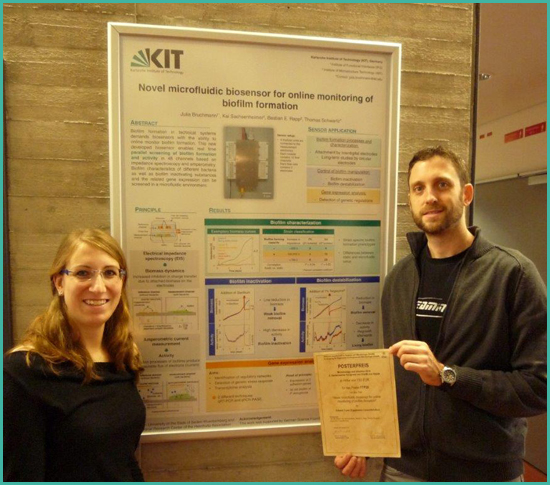Poster Prize: Novel microfluidic biosensor for online monitoring of biofilm formation
-
chair:
Bruchmann, J. / Sachsenheimer, K. / Trunkl, E. / Rapp, B. / Schwartz, T. (2014)
-
place:
KIT
-

Controlling and monitoring of biofilm formation are still demanding tasks. Established biofilm research methods mainly provide destructive end-point analysis. Therefore, we developed a new sensor system for characterizing biofilm formation online in a microfluidic flow system by two parameters: attached biomass and biofilm activity. Our newly developed microfluidic biosensor is based on electrical impedance spectroscopy and parallel measurement of amperometric current which allows the real-time monitoring of biofilm formation processes. Biofilm biomass and activity are recorded in a non-destructive manner.
Thereby increasing impedance correlates with an increase in biomass attached to the electrode and increase in amperometric measured current corresponds to a higher respiratory activity of the biofilm. These features were proven by microscopic timelapse experiments and exo-enzymatic activity measurements. Integration of a reference channel allows minimizing environmental oscillations. The microfluidic properties of the senor enable parallel screening of different bacteria as well as biofilm affecting substances by providing 48 parallel flow channels with each containing two electrodes.
A direct RNA extraction out of the channels allows transcriptome analysis on desired time-points. Using this setup we were able to monitor biofilm development of different Grampositive and Gram-negative bacterial species including Pseudomonas aeruginosa, Stenotrophomonas maltophilia, Staphylococcus aureus, Bacillus subtilis, and even complex waste water biofilms. Screening of strain collections identified different biofilm formation potentials of the strains. Furthermore, the device enables monitoring of agents with biocidal or biofilm destabilizing effects. Loosening of the EPS matrix leads to a destabilized biofilm which can be monitored online by a decrease in impedance signal. Toxicity effects of biocides cause inactivation of the biofilm and therefore a decrease in the amperometric signal is observed.
Regrowth after treatment reveals the presence of persister cells and is indicated by a recovery of both signals. Overall, this sensor provides a tool for real-time monitoring biofilm formation and allows a rapid screening of biofilm influencing substances in a microfluidic system. Ongoing development of the sensor targets the implementation into technical systems, where biofilm formation is a demanding problem and early on monitoring is necessary.